 | –≠–ª–µ–∫—Ç—Ä–æ–Ω–Ω—ã–π –∫–æ–º–ø–æ–Ω–µ–Ω—Ç: TDA8764 | –°–∫–∞—á–∞—Ç—å:  PDF PDF  ZIP ZIP |
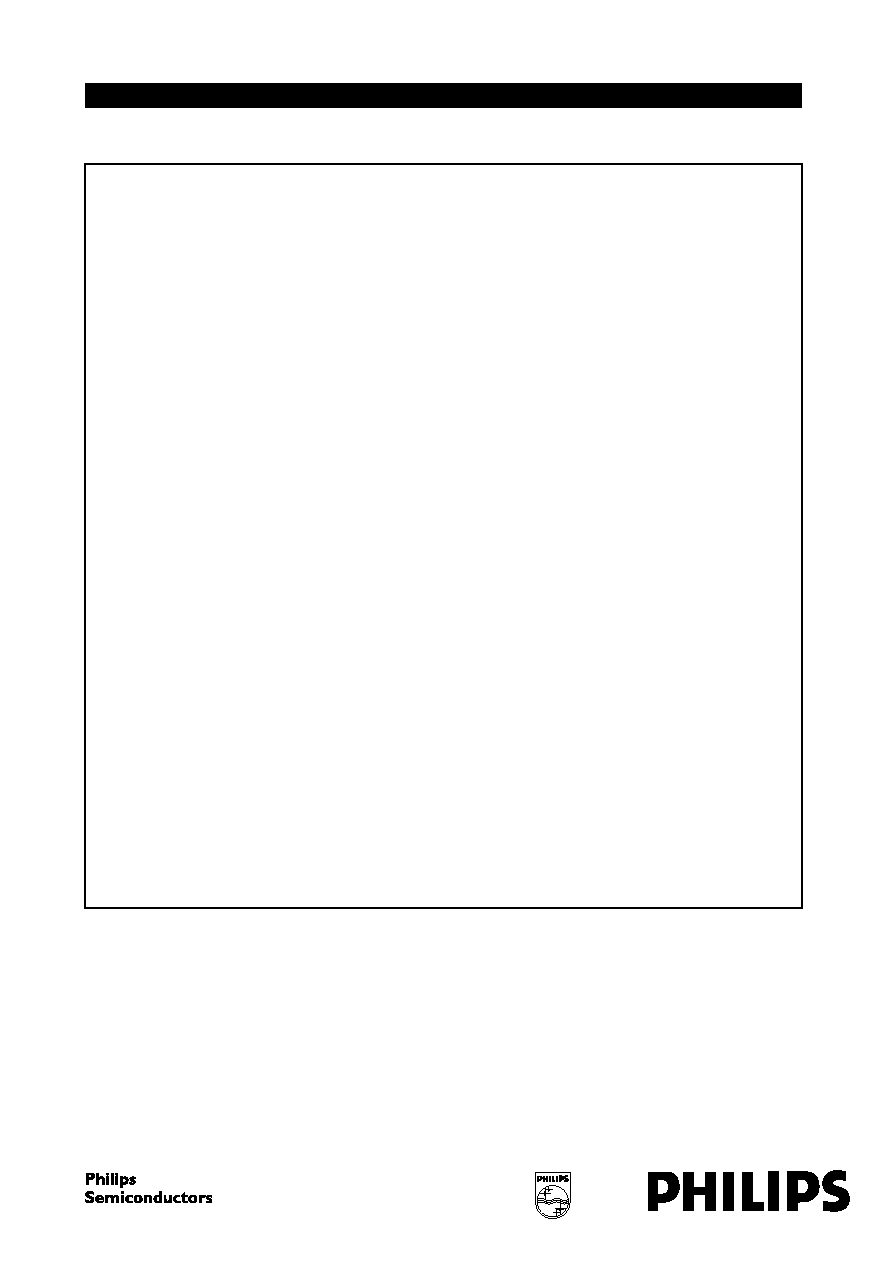
DATA SHEET
Preliminary specification
1999 Jan 12
INTEGRATED CIRCUITS
TDA8764
10-bit high-speed low-power ADC
with internal reference regulator

1999 Jan 12
2
Philips Semiconductors
Preliminary specification
10-bit high-speed low-power ADC with
internal reference regulator
TDA8764
FEATURES
∑
10-bit resolution (binary or gray code)
∑
Sampling rate up to 40 MHz (/4 version)
Sampling rate up to 80 MHz (/8 version)
∑
DC sampling allowed
∑
One clock cycle conversion only
∑
High signal-to-noise ratio over a large analog input
frequency range (9.5 effective bits at 5 MHz; full-scale
input at f
clk
= 40 MHz)
∑
No missing codes guaranteed
∑
In-Range (IR) CMOS output
∑
TTL and CMOS levels compatible digital inputs
∑
2.7 to 3.6 V CMOS digital outputs
∑
Low-level AC clock input signal allowed
∑
Internal reference voltage regulator
∑
Power dissipation only 250 mW (typical for /4 version)
Power dissipation only 375 mW (typical for /8 version)
∑
Low analog input capacitance, no buffer amplifier
required
∑
No sample-and-hold circuit required.
APPLICATIONS
High-speed analog-to-digital conversion for:
∑
Video data digitizing
∑
Radar pulse analysis
∑
Transient signal analysis
∑
High energy physics research
∑
modulators
∑
Medical imaging.
GENERAL DESCRIPTION
The TDA8764 is a 10-bit high-speed low-power
Analog-to-Digital Converter (ADC) for professional video
and other applications. It converts the analog input signal
into 10-bit binary or gray coded digital words at a maximum
sampling rate of 40 MHz (/4 version) and 80 MHz
(/8 version). All digital inputs and outputs are TTL
compatible, although a low-level sine wave clock input
signal is allowed.
The device includes an internal voltage reference
regulator.
ORDERING INFORMATION
TYPE
NUMBER
PACKAGE
SAMPLING
FREQUENCY (MHz)
NAME
DESCRIPTION
VERSION
TDA8764TS/4
SSOP28
plastic shrink small outline package; 28 leads;
body width 5.3 mm
SOT341-1
40
TDA8764TS/8
80
TDA8764HL/4
LQFP32
plastic low profile quad flat package; 32 leads;
body 5
◊
5
◊
1.4 mm
SOT401-1
40
TDA8764HL/8
80
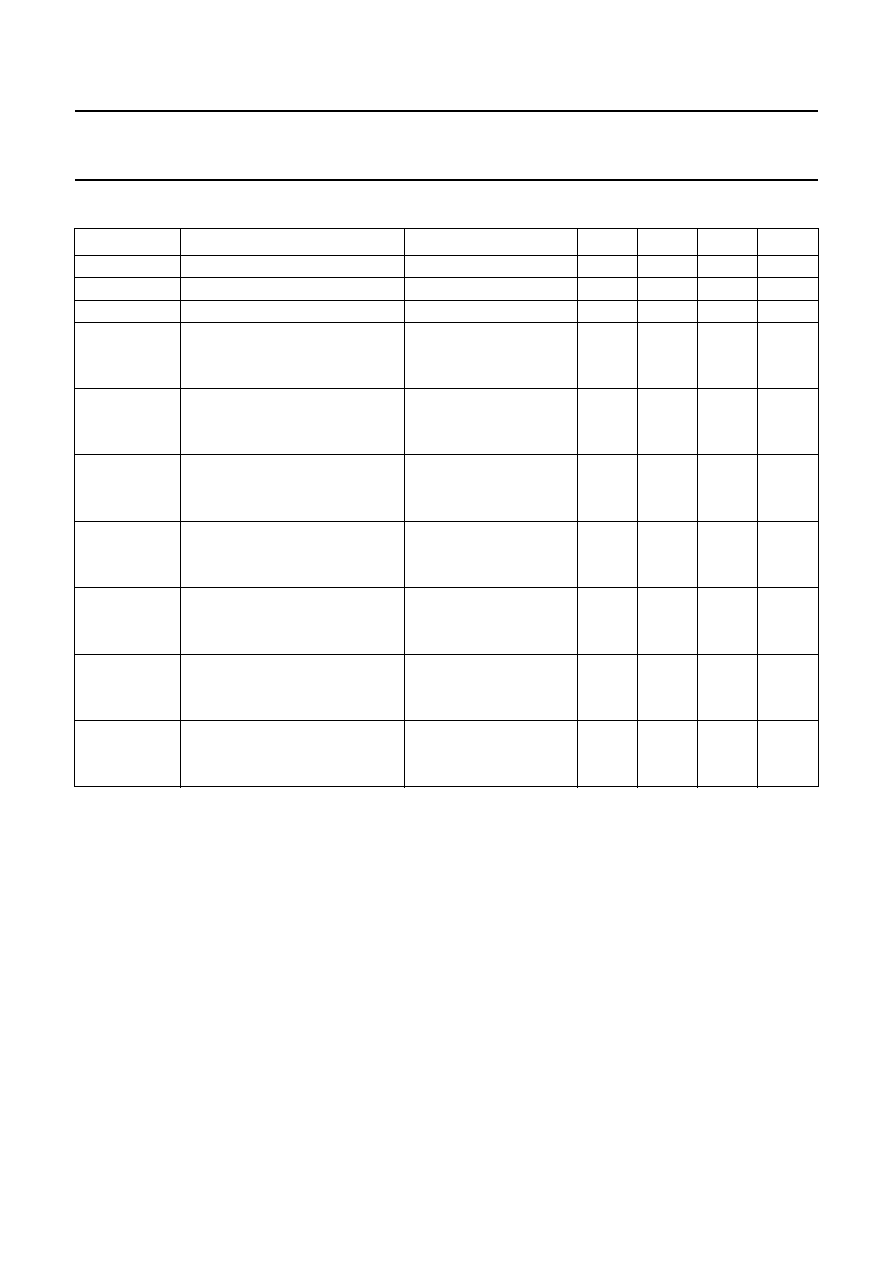
1999 Jan 12
3
Philips Semiconductors
Preliminary specification
10-bit high-speed low-power ADC with
internal reference regulator
TDA8764
QUICK REFERENCE DATA
SYMBOL
PARAMETER
CONDITIONS
MIN.
TYP.
MAX.
UNIT
V
CCA
analog supply voltage
4.75
5.0
5.25
V
V
CCD
digital supply voltage
4.75
5.0
5.25
V
V
CCO
output stages supply voltage
2.7
3.3
3.6
V
I
CCA
analog supply current
TDA8764TS/4; TDA8764HL/4
-
25
tbf
mA
TDA8764TS/8; TDA8764HL/8
-
45
tbf
mA
I
CCD
digital supply current
TDA8764TS/4; TDA8764HL/4
-
25
tbf
mA
TDA8764TS/8; TDA8764HL/8
-
30
tbf
mA
I
CCO
output stages supply current
TDA8764TS/4; TDA8764HL/4
f
clk
= 40 MHz; ramp input
-
0
tbf
mA
TDA8764TS/8; TDA8764HL/8
f
clk
= 80 MHz; ramp input
-
0
tbf
mA
INL
integral non-linearity
TDA8764TS/4; TDA8764HL/4
f
clk
= 40 MHz; ramp input
-
±
0.8
tbf
LSB
TDA8764TS/8; TDA8764HL/8
f
clk
= 80 MHz; ramp input
-
±
0.8
tbf
LSB
DNL
differential non-linearity
TDA8764TS/4; TDA8764HL/4
f
clk
= 40 MHz; ramp input
-
±
0.25
tbf
LSB
TDA8764TS/8; TDA8764HL/8
f
clk
= 80 MHz; ramp input
-
±
0.25
tbf
LSB
f
clk(max)
maximum clock frequency
TDA8764TS/4; TDA8764HL/4
40
-
-
MHz
TDA8764TS/8; TDA8764HL/8
80
-
-
MHz
P
tot
total power dissipation
TDA8764TS/4; TDA8764HL/4
f
clk
= 40 MHz; ramp input
-
250
tbf
mW
TDA8764TS/8; TDA8764HL/8
f
clk
= 80 MHz; ramp input
-
375
tbf
mW
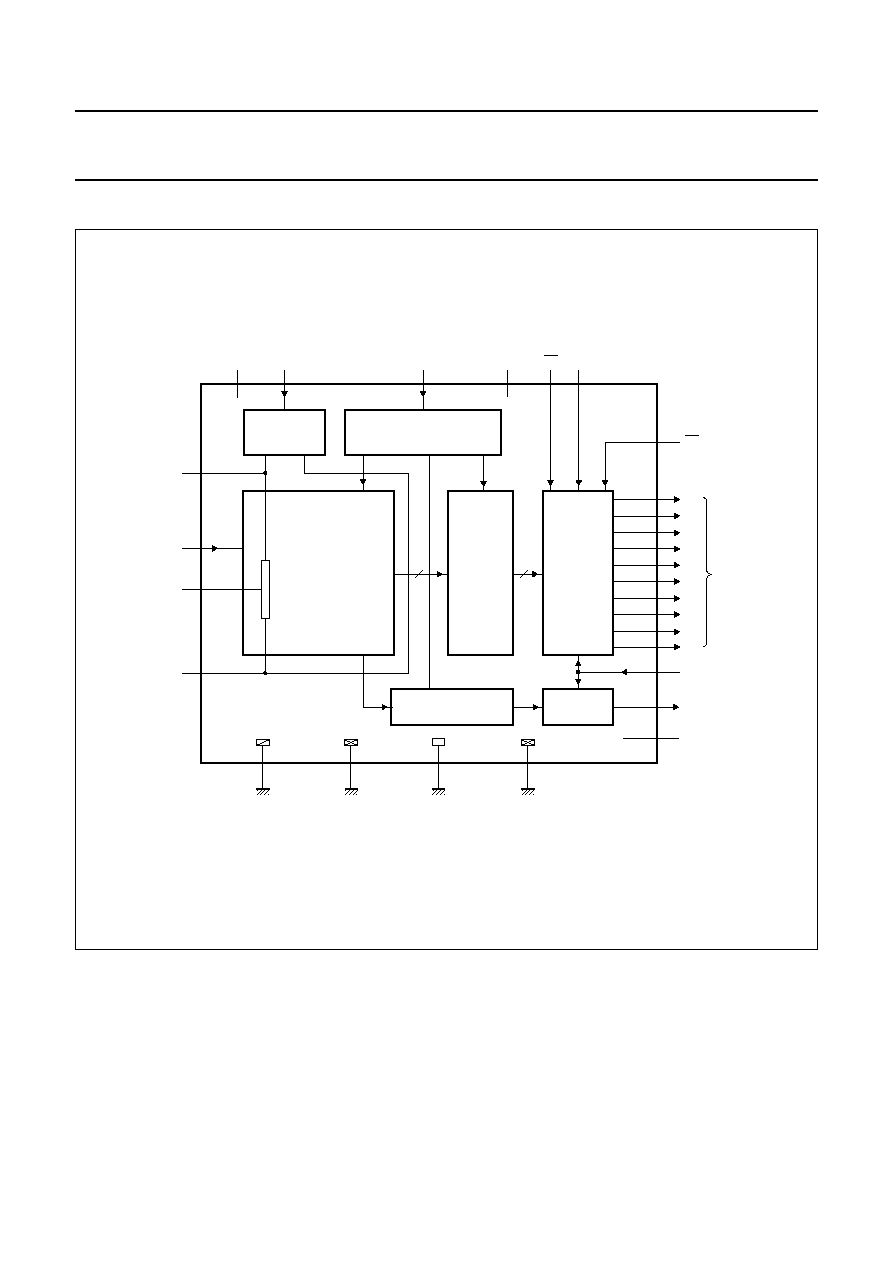
1999 Jan 12
4
Philips Semiconductors
Preliminary specification
10-bit high-speed low-power ADC with
internal reference regulator
TDA8764
BLOCK DIAGRAM
Fig.1 Block diagram.
handbook, full pagewidth
DGND2
RLAD
VRB
VRM
VRT
VI
VCCD2
VCCA
D4
D5
D6
D7
D8
D3
D2
D1
D0
D9
IN-RANGE LATCH
CMOS
OUTPUTS
LATCHES
ANALOG-TO-DIGITAL
CONVERTER
CLOCK DRIVER
REFERENCE
VOLTAGE
REGULATOR
FCE099
CMOS
OUTPUT
CLK
DEC
GRAY
TC
OE
TDA8764
VCCO
AGND
9 (15)
3 (7)
5 (10)
1 (5)
10
(16)
15 (21)
11 (17)
analog ground
digital ground
digital ground
DGND1
OGND
output ground
analog
voltage input
data outputs
LSB
MSB
VCCD1
IR output
7 (13)
6 (12)
4 (8)
12 (18)
14 (20)
27 (3)
28 (4)
26 (2)
13 (19)
16 (22)
17 (23)
18 (24)
19 (25)
20 (26)
21 (27)
22 (28)
23 (29)
24 (30)
25 (31)
2 (6)
8 (14)
The pin numbers given in parenthesis refer to the LQFP32 package.

1999 Jan 12
5
Philips Semiconductors
Preliminary specification
10-bit high-speed low-power ADC with
internal reference regulator
TDA8764
PINNING
SYMBOL
PINS
DESCRIPTION
SSOP28
LQFP32
CLK
1
5
clock input
TC
2
6
twos complement input (input active LOW)
V
CCA
3
7
analog supply voltage (+5 V)
AGND
4
8
analog ground
DEC
5
10
decoupling input
V
RB
6
12
reference voltage BOTTOM input
V
RM
7
13
reference voltage MIDDLE input
V
I
8
14
analog input voltage
V
RT
9
15
reference voltage TOP input
OE
10
16
output enable input (input active LOW)
V
CCD2
11
17
digital supply voltage 2 (+5 V)
DGND2
12
18
digital ground 2
V
CCO
13
19
supply voltage for output stages (2.7 to 3.6 V)
OGND
14
20
output ground
GRAY
15
21
gray code input (input active HIGH)
D0
16
22
data output; bit 0 (LSB)
D1
17
23
data output; bit 1
D2
18
24
data output; bit 2
D3
19
25
data output; bit 3
D4
20
26
data output; bit 4
D5
21
27
data output; bit 5
D6
22
28
data output; bit 6
D7
23
29
data output; bit 7
D8
24
30
data output; bit 8
D9
25
31
data output; bit 9 (MSB)
IR
26
2
in-range data output
DGND1
27
3
digital ground 1
V
CCD1
28
4
digital supply voltage 1 (+5 V)
n.c.
-
1, 9, 11 and 32 not connected
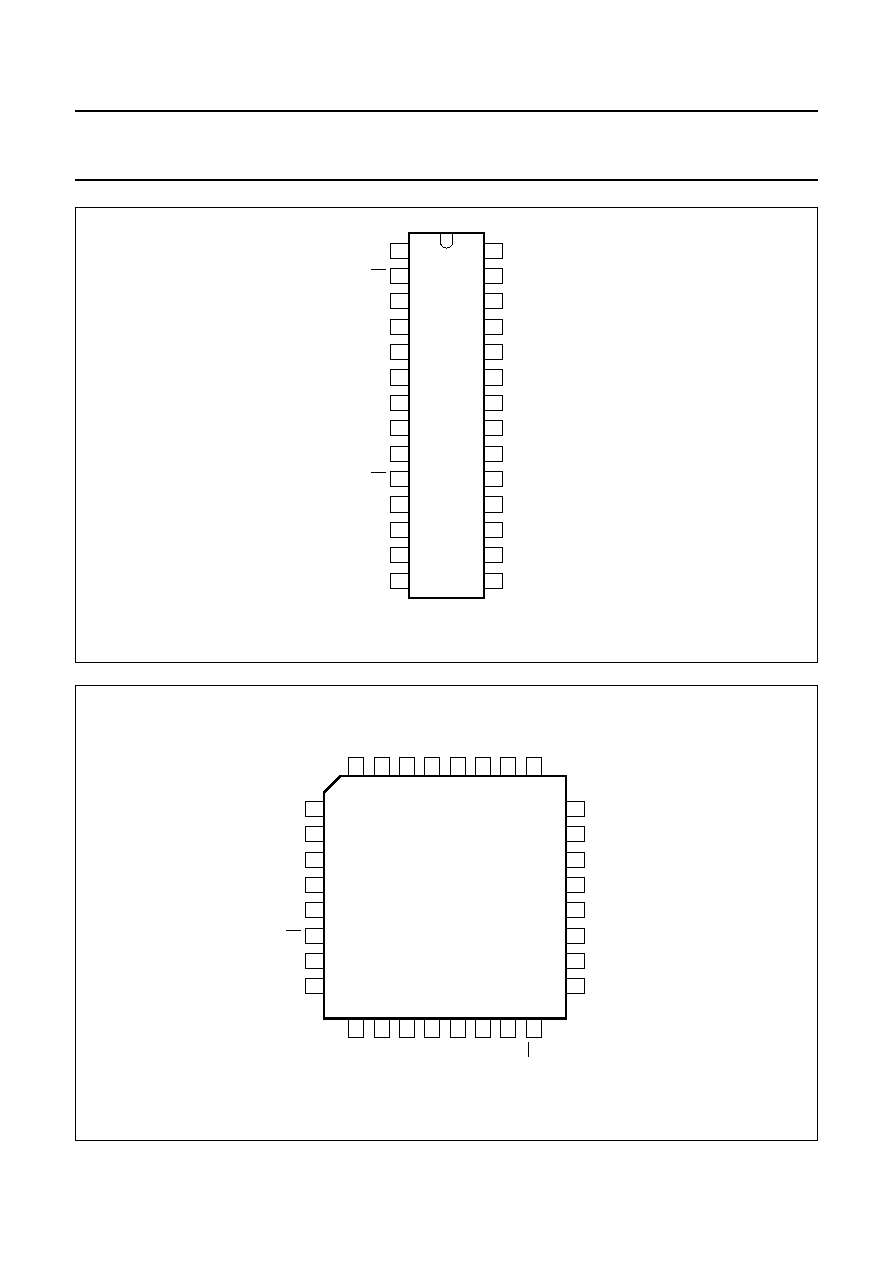
1999 Jan 12
6
Philips Semiconductors
Preliminary specification
10-bit high-speed low-power ADC with
internal reference regulator
TDA8764
Fig.2 Pin configuration (SSOP28).
handbook, halfpage
CLK
D9
D7
D6
D8
D5
D4
D3
D2
D1
D0
1
2
3
4
5
6
7
8
9
10
11
12
13
28
27
26
25
24
23
22
21
20
19
18
17
16
15
14
TDA8764TS
FCE100
IR
DGND1
VCCD1
VCCA
AGND
VCCD2
DGND2
OGND
GRAY
VCCO
DEC
VRB
VI
VRT
VRM
TC
OE
Fig.3 Pin configuration (LQFP32).
handbook, full pagewidth
TDA8764HL
FCE125
1
2
3
4
5
6
7
8
24
23
22
21
20
19
18
17
9
10
11
12
13
14
15
16
32
31
30
29
28
27
26
25
n.c.
IR
DGND1
VCCD1
CLK
TC
VCCA
AGND
D3
D4
D5
D6
D7
D8
D9
n.c.
VCCD2
DGND2
OGND
D2
D0
GRAY
D1
VCCO
n.c.
DEC
n.c.
V
RB
V
I
V
RT
OE
V
RM

1999 Jan 12
7
Philips Semiconductors
Preliminary specification
10-bit high-speed low-power ADC with
internal reference regulator
TDA8764
LIMITING VALUES
In accordance with the Absolute Maximum Rating System (IEC 134).
Note
1. The supply voltages V
CCA
, V
CCD
and V
CCO
may have any value between
-
0.3 V and +7.0 V provided that the supply
voltage differences
V
CC
are respected.
HANDLING
Inputs and outputs are protected against electrostatic discharges in normal handling. However, to be totally safe, it is
desirable to take normal precautions appropriate to handling integrated circuits.
THERMAL CHARACTERISTICS
SYMBOL
PARAMETER
CONDITIONS
MIN.
MAX.
UNIT
V
CCA
analog supply voltage
note 1
-
0.3
+7.0
V
V
CCD
digital supply voltage
note 1
-
0.3
+7.0
V
V
CCO
output stages supply voltage
note 1
-
0.3
+7.0
V
V
CC
supply voltage difference
V
CCA
-
V
CCD
-
1.0
+1.0
V
V
CCA
-
V
CCO
-
1.0
+4.0
V
V
CCD
-
V
CCO
-
1.0
+4.0
V
V
I
input voltage
referenced to AGND
-
0.3
+7.0
V
V
i(sw)(p-p)
AC input voltage for switching (peak-to-peak value) referenced to DGND
-
V
CCD
V
I
O
output current
-
10
mA
T
stg
storage temperature
-
55
+150
∞
C
T
amb
operating ambient temperature
-
40
+85
∞
C
T
j
junction temperature
-
150
∞
C
SYMBOL
PARAMETER
CONDITIONS
VALUE
UNIT
R
th(j-a)
thermal resistance from junction to ambient
in free air
SSOP28
110
K/W
LQFP32
90
K/W
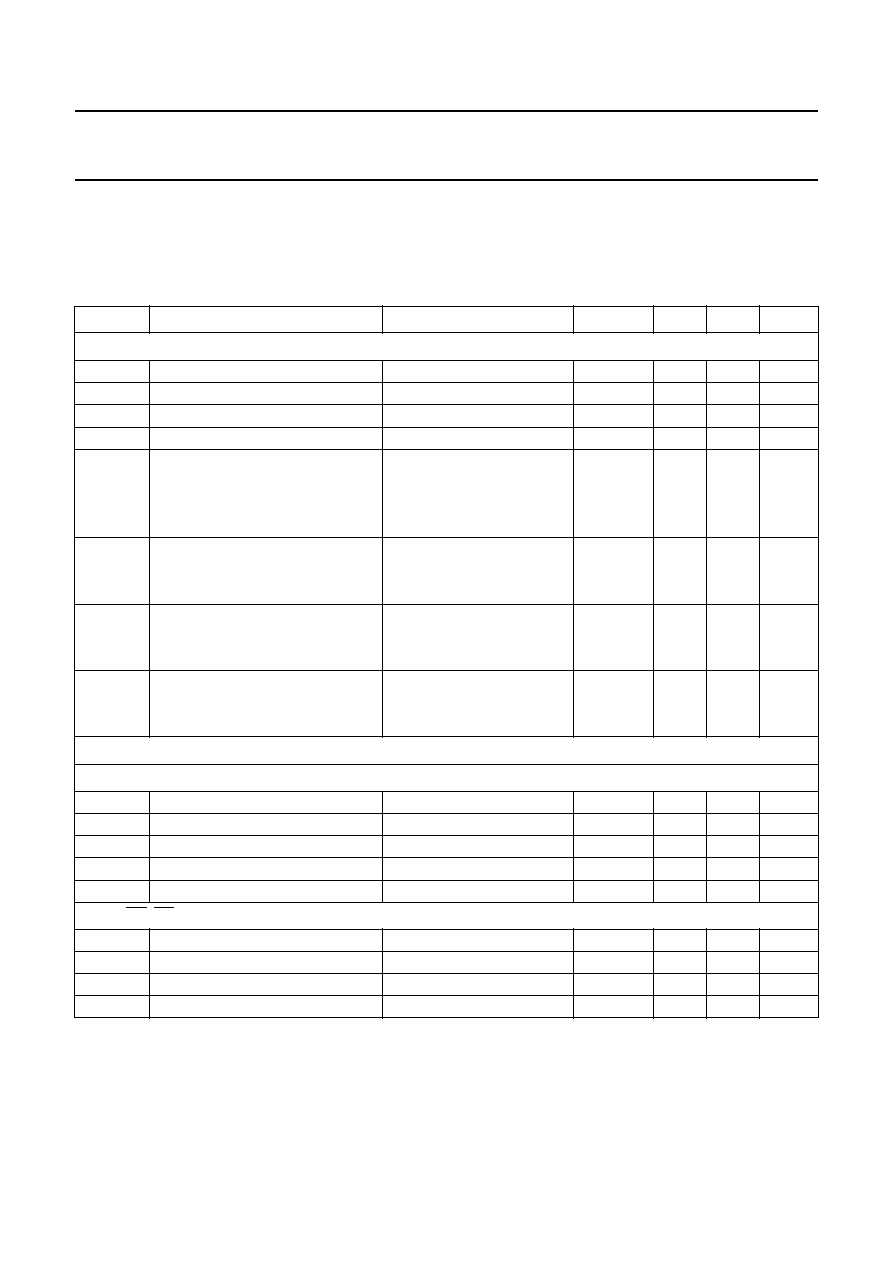
1999 Jan 12
8
Philips Semiconductors
Preliminary specification
10-bit high-speed low-power ADC with
internal reference regulator
TDA8764
CHARACTERISTICS
The characteristics given refer to the SSOP28 package. V
CCA
= V
3
to V
4
= 4.75 to 5.25 V;
V
CCD
= V
11
to V
12
and V
28
to V
27
= 4.75 to 5.25 V; V
CCO
= V
13
to V
14
= 2.7 to 3.6 V; AGND and DGND shorted
together; T
amb
= 0 to 70
∞
C; typical values measured at V
CCA
= V
CCD
= 5 V and V
CCO
= 3.3 V; C
L
= 10 pF and
T
amb
= 25
∞
C; unless otherwise specified.
SYMBOL
PARAMETER
CONDITIONS
MIN.
TYP.
MAX.
UNIT
Supplies
V
CCA
analog supply voltage
4.75
5.0
5.25
V
V
CCD1
digital supply voltage 1
4.75
5.0
5.25
V
V
CCD2
digital supply voltage 2
4.75
5.0
5.25
V
V
CCO
output stages supply voltage
2.7
3.3
3.6
V
V
CC
supply voltage difference
V
CCA
-
V
CCD
-
0.20
-
+0.20
V
V
CCA
-
V
CCO
-
0.20
-
+2.55
V
V
CCD
-
V
CCO
-
0.20
-
+2.55
V
I
CCA
analog supply current
TDA8764TS/4; TDA8764HL/4
-
25
tbf
mA
TDA8764TS/8; TDA8764HL/8
-
45
tbf
mA
I
CCD
digital supply current
TDA8764TS/4; TDA8764HL/4
-
25
tbf
mA
TDA8764TS/8; TDA8764HL/8
-
30
tbf
mA
I
CCO
output stages supply current
TDA8764TS/4; TDA8764HL/4
f
clk
= 40 MHz; ramp input
-
0
tbf
mA
TDA8764TS/8; TDA8764HL/8
f
clk
= 80 MHz; ramp input
-
0
tbf
mA
Inputs
C
LOCK INPUT
; CLK (
REFERENCED TO
DGND); note 1
V
IL
LOW-level input voltage
0
-
0.8
V
V
IH
HIGH-level input voltage
2
-
V
CCD
V
I
IL
LOW-level input current
V
CLK
= 0.8 V
-
1
0
+1
µ
A
I
IH
HIGH-level input current
V
CLK
= 2 V
-
2
10
µ
A
C
i
input capacitance
-
2
-
pF
I
NPUTS
OE, TC
AND
GRAY (
REFERENCED TO
DGND); see Tables 3 and 4
V
IL
LOW-level input voltage
0
-
0.8
V
V
IH
HIGH-level input voltage
2
-
V
CCD
V
I
IL
LOW-level input current
V
IL
= 0.8 V
-
1
-
-
µ
A
I
IH
HIGH-level input current
V
IH
= 2 V
-
-
1
µ
A
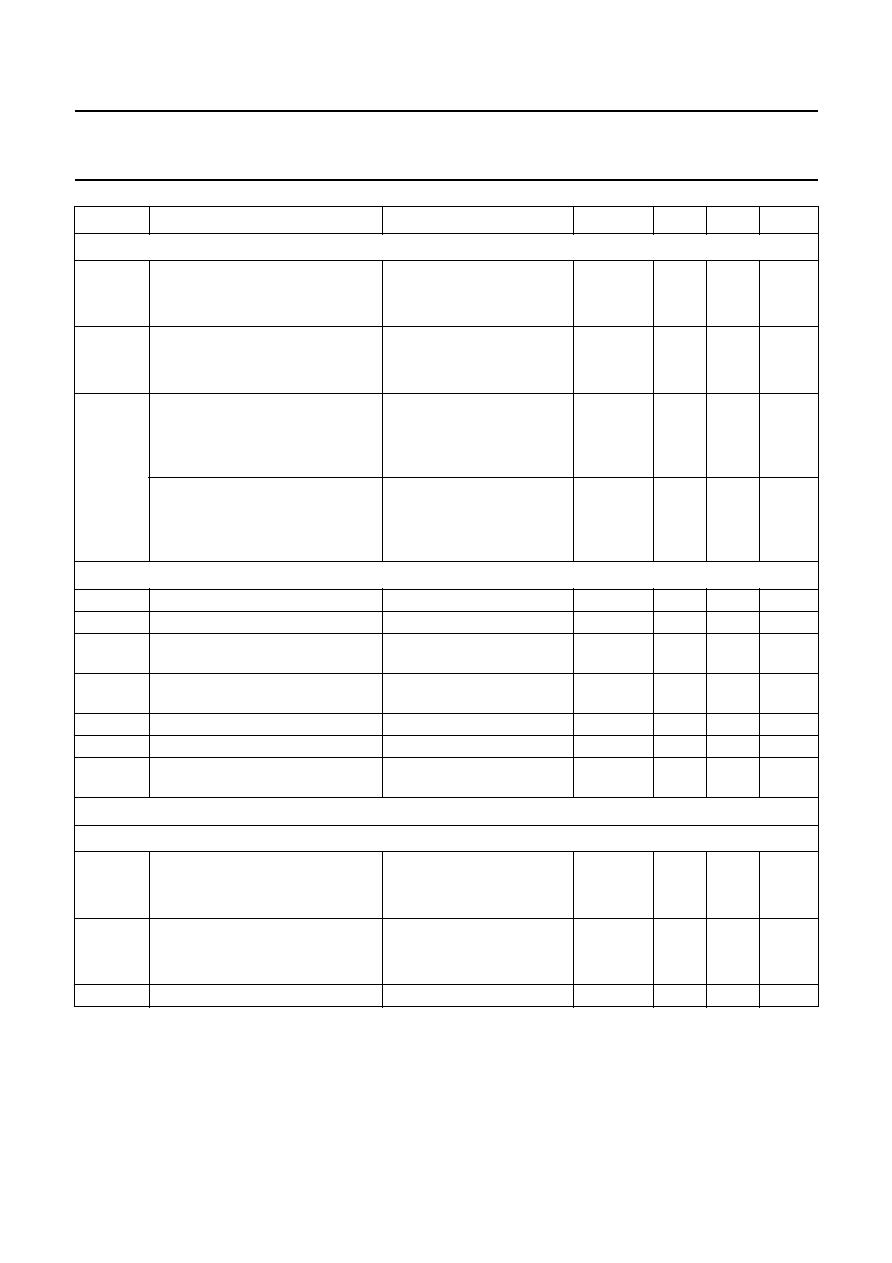
1999 Jan 12
9
Philips Semiconductors
Preliminary specification
10-bit high-speed low-power ADC with
internal reference regulator
TDA8764
V
I
(
ANALOG INPUT VOLTAGE REFERENCED TO
AGND)
I
IL
LOW-level input current
TDA8764TS/4; TDA8764HL/4
V
I
= V
RB
-
0
-
µ
A
TDA8764TS/8; TDA8764HL/8
V
I
= V
RB
-
0
-
µ
A
I
IH
HIGH-level input current
TDA8764TS/4; TDA8764HL/4
V
I
= V
RT
-
45
-
µ
A
TDA8764TS/8; TDA8764HL/8
V
I
= V
RT
-
85
-
µ
A
Y
i
input admittance
TDA8764TS/4; TDA8764HL/4
f
i
= 5 MHz; note 2
input resistance
-
70
-
k
input capacitance
3
5
7
pF
input admittance
TDA8764TS/8; TDA8764HL/8
f
i
= 5 MHz; note 2
input resistance
-
45
-
k
input capacitance
3
5
7
pF
Reference voltages for the resistor ladder using the internal voltage regulator; see Table 1
V
RB
reference voltage BOTTOM
tbf
1.3
tbf
V
V
RT
reference voltage TOP
tbf
3.7
tbf
V
V
diff(ref)
differential reference voltage
V
RT
-
V
RB
tbf
2.4
tbf
V
TC
Vdiff
temperature coefficient of
differential reference voltage
-
tbf
-
mV/K
V
offset(B)
offset voltage BOTTOM
note 3
-
161
-
mV
V
offset(T)
offset voltage TOP
note 3
-
161
-
mV
V
I(p-p)
analog input voltage
(peak-to-peak value)
note 4
tbf
2.08
tbf
V
Outputs
D
IGITAL OUTPUTS
D9
TO
D0
AND
IR (
REFERENCED TO
OGND)
V
OL
LOW-level output voltage
TDA8764TS/4; TDA8764HL/4
I
OL
= 1 mA
0
-
0.5
V
TDA8764TS/8; TDA8764HL/8
I
OL
= 2 mA
0
-
0.5
V
V
OH
HIGH-level output voltage
TDA8764TS/4; TDA8764HL/4
I
OH
=
-
1 mA
V
CCO
-
0.5
-
V
CCO
V
TDA8764TS/8; TDA8764HL/8
I
OH
=
-
2 mA
V
CCO
-
0.5
-
V
CCO
V
I
OZ
output current in 3-state mode
0.5 V < V
o
< V
CCO
-
20
-
+20
µ
A
SYMBOL
PARAMETER
CONDITIONS
MIN.
TYP.
MAX.
UNIT
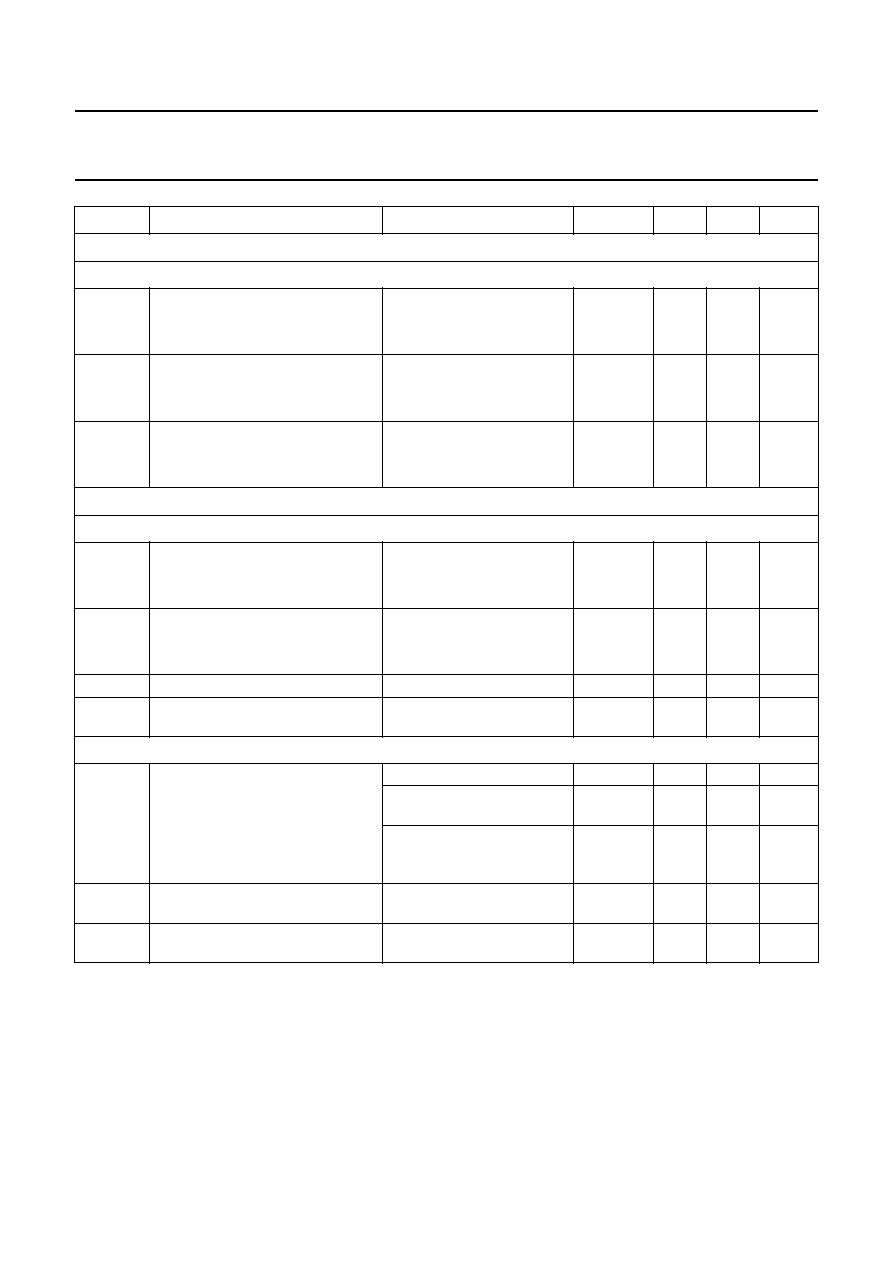
1999 Jan 12
10
Philips Semiconductors
Preliminary specification
10-bit high-speed low-power ADC with
internal reference regulator
TDA8764
Switching characteristics
C
LOCK INPUT
; CLK; see Fig.5; note 1
f
clk(max)
maximum clock frequency
TDA8764TS/4; TDA8764HL/4
40
-
-
MHz
TDA8764TS/8; TDA8764HL/8
80
-
-
MHz
t
CPH
clock pulse width HIGH
TDA8764TS/4; TDA8764HL/4
7
-
-
ns
TDA8764TS/8; TDA8764HL/8
5
-
-
ns
t
CPL
clock pulse width LOW
TDA8764TS/4; TDA8764HL/4
7
-
-
ns
TDA8764TS/8; TDA8764HL/8
5
-
-
ns
Analog signal processing
L
INEARITY
INL
integral non-linearity
TDA8764TS/4; TDA8764HL/4
f
clk
= 40 MHz; ramp input
-
±
0.8
tbf
LSB
TDA8764TS/8; TDA8764HL/8
f
clk
= 80 MHz; ramp input
-
±
0.8
tbf
LSB
DNL
differential non-linearity
TDA8764TS/4; TDA8764HL/4
f
clk
= 40 MHz; ramp input
-
±
0.25
tbf
LSB
TDA8764TS/8; TDA8764HL/8
f
clk
= 80 MHz; ramp input
-
±
0.25
tbf
LSB
E
offset
offset error
middle code
-
±
1
-
LSB
E
G
gain error (from device to device)
using internal reference voltage
note 5
-
tbf
-
%
B
ANDWIDTH
(f
clk
= 40 MH
Z
)/4
VERSION
;
B
analog bandwidth
full-scale sine wave; note 6
-
20
-
MHz
75% full-scale sine wave;
note 6
-
30
-
MHz
small signal at mid-scale;
V
I
=
±
10 LSB at code 512;
note 6
-
350
-
MHz
t
stLH
analog input settling time
LOW-to-HIGH
full-scale square wave;
see Fig.7 and note 7
-
tbf
tbf
ns
t
stHL
analog input settling time
HIGH-to-LOW
full-scale square wave;
see Fig.7 and note 7
-
tbf
tbf
ns
SYMBOL
PARAMETER
CONDITIONS
MIN.
TYP.
MAX.
UNIT

1999 Jan 12
11
Philips Semiconductors
Preliminary specification
10-bit high-speed low-power ADC with
internal reference regulator
TDA8764
B
ANDWIDTH
(f
clk
= 80 MH
Z
) /8
VERSION
;
B
analog bandwidth
full-scale sine wave; note 6
-
40
-
MHz
75% full-scale sine wave;
note 6
-
60
-
MHz
small signal at mid-scale;
V
i
=
±
10 LSB at code 512;
note 6
-
700
-
MHz
t
stLH
analog input settling time
LOW-to-HIGH
full-scale square wave;
see Fig.7 and note 7
-
tbf
tbf
ns
t
stHL
analog input settling time
HIGH-to-LOW
full-scale square wave;
see Fig.7 and note 7
-
tbf
tbf
ns
H
ARMONICS
(f
clk
= 40 MH
Z
) /4
VERSION
;
H
all(FS)
harmonics (full-scale);
all components
f
i
= 5 MHz
second harmonics
-
-
70
tbf
dBc
third harmonics
-
-
90
tbf
dBc
SFDR
spurious free dynamic range
f
i
= 5 MHz
-
tbf
-
dBc
THD
total harmonic distortion
f
i
= 5 MHz
-
-
70
-
dB
H
ARMONICS
(f
clk
= 80 MH
Z
)/8
VERSION
;
H
all(FS)
harmonics (full-scale);
all components
f
i
= 5 MHz
second harmonics
-
-
71
tbf
dBc
third harmonics
-
-
87
tbf
dBc
SFDR
spurious free dynamic range
f
i
= 5 MHz
-
tbf
-
dBc
THD
total harmonic distortion
f
i
= 5 MHz
-
-
70
-
dB
S
IGNAL
-
TO
-
NOISE RATIO
; note 8
SNR
(FS)
signal-to-noise ratio (full-scale)
without harmonics;
f
i
= 5 MHz
f
clk
= 40 MHz; /4 version
tbf
58
-
dB
f
clk
= 80 MHz; /8 version
tbf
58
-
dB
E
FFECTIVE BITS
; note 8
EB
effective bits
TDA8764TS/4; TDA8764HL/4
f
clk
= 40 MHz
f
i
= 5 MHz
tbf
9.5
tbf
bits
f
i
= 7.5 MHz
tbf
9.2
tbf
bits
f
i
= 10 MHz
tbf
9.0
tbf
bits
f
i
= 20 MHz
tbf
tbf
tbf
bits
effective bits
TDA8764TS/8; TDA8764HL/8
f
clk
= 80 MHz
f
i
= 5 MHz
tbf
9.5
tbf
bits
f
i
= 10 MHz
tbf
tbf
tbf
bits
f
i
= 20 MHz
tbf
tbf
tbf
bits
f
i
= 40 MHz
tbf
tbf
tbf
bits
SYMBOL
PARAMETER
CONDITIONS
MIN.
TYP.
MAX.
UNIT
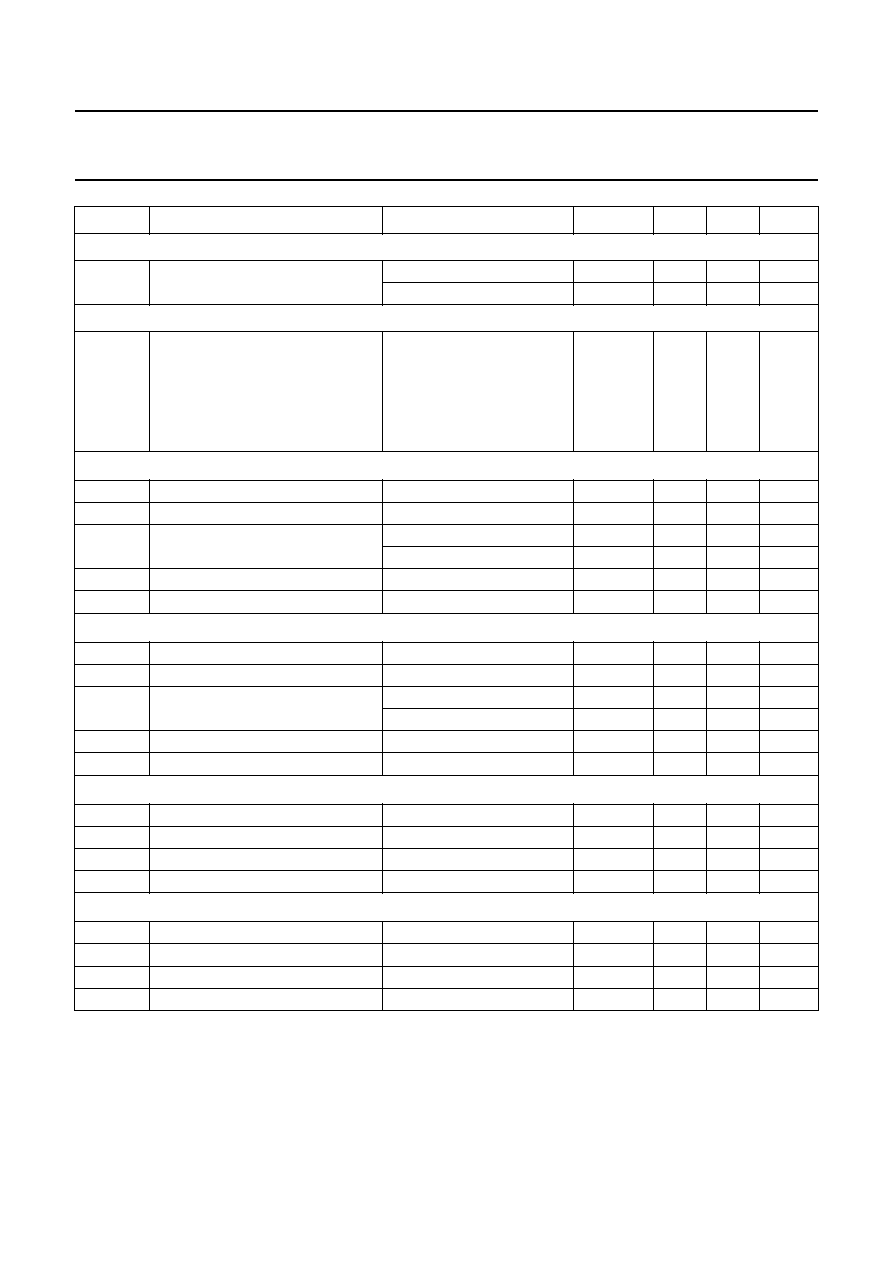
1999 Jan 12
12
Philips Semiconductors
Preliminary specification
10-bit high-speed low-power ADC with
internal reference regulator
TDA8764
T
WO
-
TONE
; note 9
TTID
two-tone intermodulation distortion
f
clk
= 40 MHz
-
tbf
-
dB
f
clk
= 80 MHz
-
tbf
-
dB
B
IT ERROR RATE
BER
bit error rate
f
i
= 5 MHz; V
i
=
±
16 LSB at
code 512
f
clk
= 40 MHz
-
10
-
13
-
times/
sample
f
clk
= 80 MHz
-
10
-
13
-
times/
sample
Timing (f
clk
= 40 MHz; C
L
= 10 pF) /4 version; see Fig.5 and note 10
t
ds
sampling delay time
-
-
2
ns
t
h
output hold time
5
-
-
ns
t
d
output delay time
V
CCO
= 2.7 V
tbf
12
tbf
ns
V
CCO
= 3.3 V
tbf
11
tbf
ns
C
L
digital output load capacitance
-
-
10
pF
SR
slew rate
V
CCO
= 2.7 V; C
L
= 10 pF
-
-
tbf
V/
µ
s
Timing (f
clk
= 80 MHz; C
L
= 10 pF) /8 version; see Fig.5 and note 10
t
ds
sampling delay time
-
-
2
ns
t
h
output hold time
4
-
-
ns
t
d
output delay time
V
CCO
= 2.7 V
tbf
8
tbf
ns
V
CCO
= 3.3 V
tbf
7
tbf
ns
C
L
digital output load capacitance
-
-
10
pF
SR
slew rate
V
CCO
= 2.7 V; C
L
= 10 pF
-
-
tbf
V/
µ
s
3-state output delay times (f
clk
= 40 MHz) /4 version; see Fig.6
t
dZH
enable HIGH
-
tbf
tbf
ns
t
dZL
enable LOW
-
tbf
tbf
ns
t
dHZ
disable HIGH
-
tbf
tbf
ns
t
dLZ
disable LOW
-
tbf
tbf
ns
3-state output delay times (f
clk
= 80 MHz) /8 version; see Fig.6
t
dZH
enable HIGH
-
tbf
tbf
ns
t
dZL
enable LOW
-
tbf
tbf
ns
t
dHZ
disable HIGH
-
tbf
tbf
ns
t
dLZ
disable LOW
-
tbf
tbf
ns
SYMBOL
PARAMETER
CONDITIONS
MIN.
TYP.
MAX.
UNIT

1999 Jan 12
13
Philips Semiconductors
Preliminary specification
10-bit high-speed low-power ADC with
internal reference regulator
TDA8764
Notes
1. In addition to a good layout of the digital and analog ground, it is recommended that the rise and fall times of the clock
must not be less than 0.5 ns.
2. The input admittance is
3. Analog input voltages producing code 0 up to and including code 1023:
a) V
offset(B)
(offset voltage BOTTOM) is the difference between the analog input which produces data equal to 00
and the reference voltage BOTTOM (V
RB
) at T
amb
= 25
∞
C.
b) V
offset(T)
(offset voltage TOP) is the difference between reference voltage TOP (V
RT
) and the analog input which
produces data outputs equal to code 1023 at T
amb
= 25
∞
C.
4. In order to ensure the optimum linearity performance of such converter architecture the lower and upper extremities
of the converter reference resistor ladder (corresponding to output codes 0 and 1023 respectively) are connected to
pins V
RB
and V
RT
via offset resistors R
OB
and R
OT
as shown in Fig.4.
a) The current flowing into the resistor ladder is
and the full-scale input range at the converter,
to cover code 0 to code 1023, is
b) Since R
L
, R
OB
and R
OT
have similar behaviour with respect to process and temperature variation, the ratio
will be kept reasonably constant from device to device. Consequently variation of the output
codes at a given input voltage depends mainly on the difference V
RT
-
V
RB
and its variation with temperature and
supply voltage. When several ADCs are connected in parallel and fed with the same reference source, the
matching between each of them is then optimized.
5.
6. The analog bandwidth is defined as the maximum input sine wave frequency which can be applied to the device.
No glitches greater than 2 LSBs, nor any significant attenuation are observed in the reconstructed signal.
7. The analog input settling time is the minimum time required for the input signal to be stabilized after a sharp full-scale
input (square wave signal) in order to sample the signal and obtain correct output data.
8. Effective bits are obtained via a Fast Fourier Transform (FFT) treatment taking 8 K acquisition points per equivalent
fundamental period. The calculation takes into account all harmonics and noise up to half of the clock frequency
(NYQUIST frequency). Conversion to signal-to-noise ratio: SINAD = EB
◊
6.02 + 1.76 dB.
9. Intermodulation measured relative to either tone with analog input frequencies of 5 and 5.1 MHz. The two input
signals have the same amplitude and the total amplitude of both signals provides full-scale to the converter.
10. Output data acquisition: the output data is available after the maximum delay time of t
d(max)
. For the 80 MHz version
it is recommended to have the lowest possible output load.
V
i
1
R
i
-----
Cijw
+
=
I
L
V
RT
V
RB
≠
R
OB
R
L
R
OT
+
+
------------------------------------------
=
V
I
R
L
I
L
◊
R
L
R
OB
R
L
R
OT
+
+
------------------------------------------
V
RT
V
RB
≠
(
)
0.866
V
RT
V
RB
≠
(
)
◊
=
◊
=
=
R
L
R
OB
R
L
R
OT
+
+
------------------------------------------
E
G
V
1023
V
0
≠
(
)
V
i p
p
≠
(
)
≠
V
i p
p
≠
(
)
------------------------------------------------------------
100
◊
=
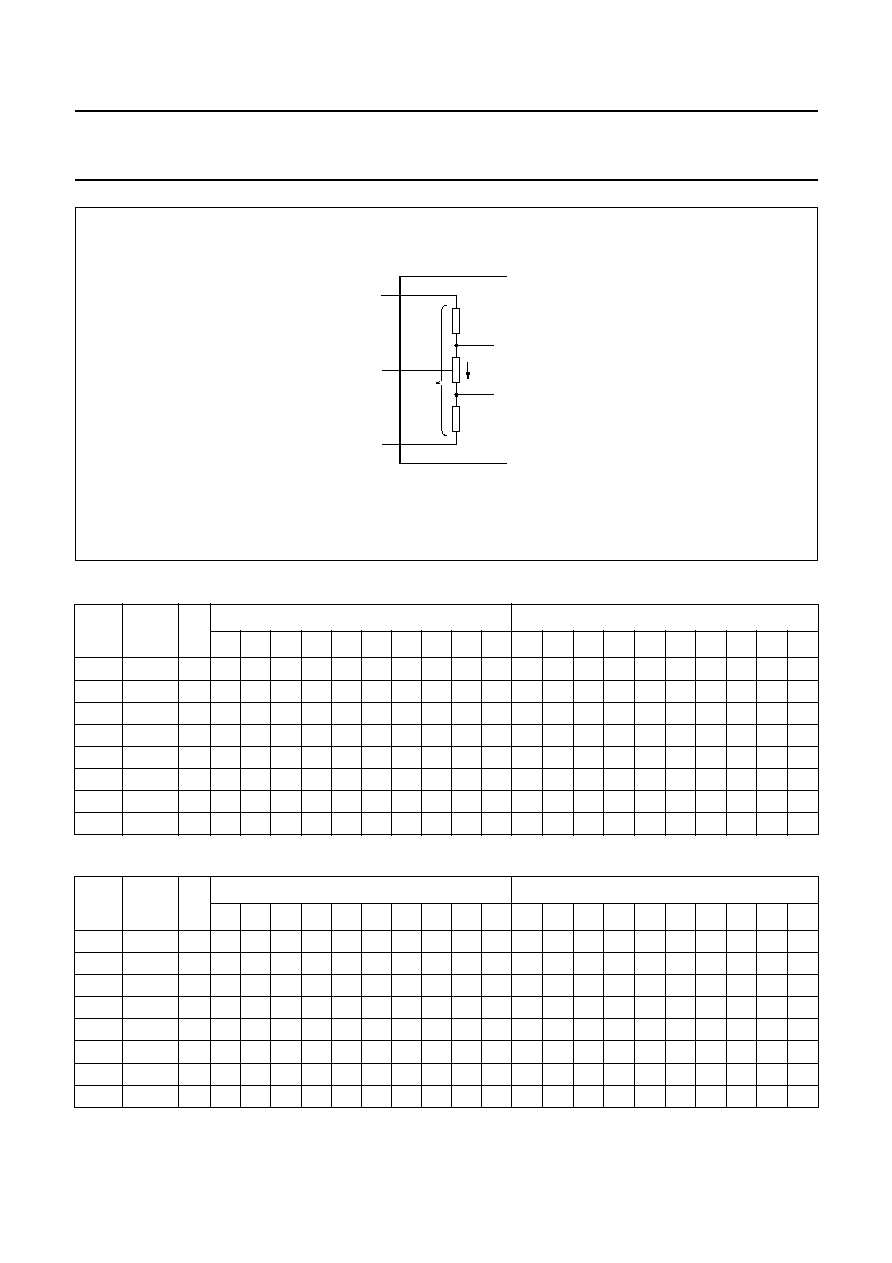
1999 Jan 12
14
Philips Semiconductors
Preliminary specification
10-bit high-speed low-power ADC with
internal reference regulator
TDA8764
Table 1
Output coding and input voltage (typical values; referenced to AGND); binary and gray codes
Table 2
Output coding and input voltage (typical values; referenced to AGND); binary and twos complement codes
STEP
V
i(p-p)
IR
BINARY OUTPUT BITS
GRAY OUTPUT BITS
D9 D8 D7 D6 D5 D4 D3 D2 D1 D0 D9 D8 D7 D6 D5 D4 D3 D2 D1 D0
U/F
<tbf
0
0
0
0
0
0
0
0
0
0
0
0
0
0
0
0
0
0
0
0
0
0
tbf
1
0
0
0
0
0
0
0
0
0
0
0
0
0
0
0
0
0
0
0
0
1
...
1
0
0
0
0
0
0
0
0
0
1
0
0
0
0
0
0
0
0
0
1
...
...
...
...
...
...
...
...
...
...
...
...
...
...
...
...
...
...
...
...
...
...
...
...
...
...
...
...
...
...
...
...
...
...
...
...
...
...
...
...
...
...
...
...
...
...
1022
...
1
1
1
1
1
1
1
1
1
1
0
1
0
0
0
0
0
0
0
0
1
1023
tbf
1
1
1
1
1
1
1
1
1
1
1
1
0
0
0
0
0
0
0
0
0
O/F
>tbf
0
1
1
1
1
1
1
1
1
1
1
1
0
0
0
0
0
0
0
0
0
STEP
V
i(p-p)
IR
BINARY OUTPUT BITS
TWO'S COMPLEMENT OUTPUT BITS
D9 D8 D7 D6 D5 D4 D3 D2 D1 D0 D9 D8 D7 D6 D5 D4 D3 D2 D1 D0
U/F
<tbf
0
0
0
0
0
0
0
0
0
0
0
1
0
0
0
0
0
0
0
0
0
0
tbf
1
0
0
0
0
0
0
0
0
0
0
1
0
0
0
0
0
0
0
0
0
1
...
1
0
0
0
0
0
0
0
0
0
1
1
0
0
0
0
0
0
0
0
1
...
...
...
...
...
...
...
...
...
...
...
...
...
...
...
...
...
...
...
...
...
...
...
...
...
...
...
...
...
...
...
...
...
...
...
...
...
...
...
...
...
...
...
...
...
...
1022
...
1
1
1
1
1
1
1
1
1
1
0
0
1
1
1
1
1
1
1
1
0
1023
tbf
1
1
1
1
1
1
1
1
1
1
1
0
1
1
1
1
1
1
1
1
1
O/F
>tbf
0
1
1
1
1
1
1
1
1
1
1
0
1
1
1
1
1
1
1
1
1
Fig.4 Explanation of note 4.
handbook, halfpage
RLAD
ROT
VRT
VRM
VRB
ROB
code 1023
code 0
MGD281
IL
RL
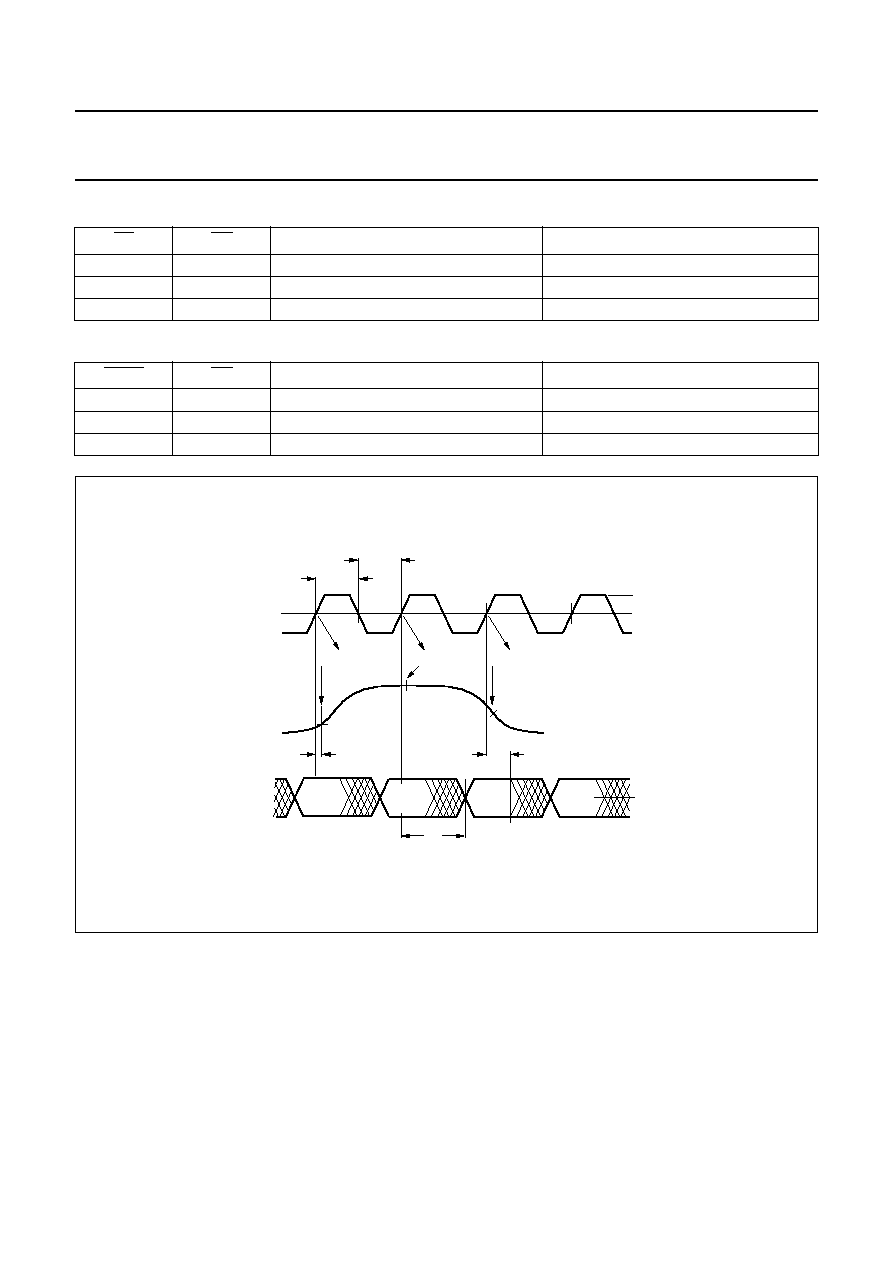
1999 Jan 12
15
Philips Semiconductors
Preliminary specification
10-bit high-speed low-power ADC with
internal reference regulator
TDA8764
Table 3
Mode selection
Table 4
Mode selection
TC
OE
D9 TO D0
IR
X
1
high impedance
high impedance
0
0
active; two complement
active
1
0
active; binary
active
GRAY
OE
D9 TO D0
IR
X
1
high impedance
high impedance
0
0
active; binary
active
1
0
active; gray
active
Fig.5 Timing diagram.
handbook, full pagewidth
ds
t
sample N + 1
sample N
CLK
MBG916
sample N + 2
0 V
50%
VCCO
0 V
50%
VCCO
V
l
DATA
D0 to D9
t d
t h
CPH
t
CPL
t
DATA
N + 1
DATA
N
DATA
N - 1
DATA
N - 2
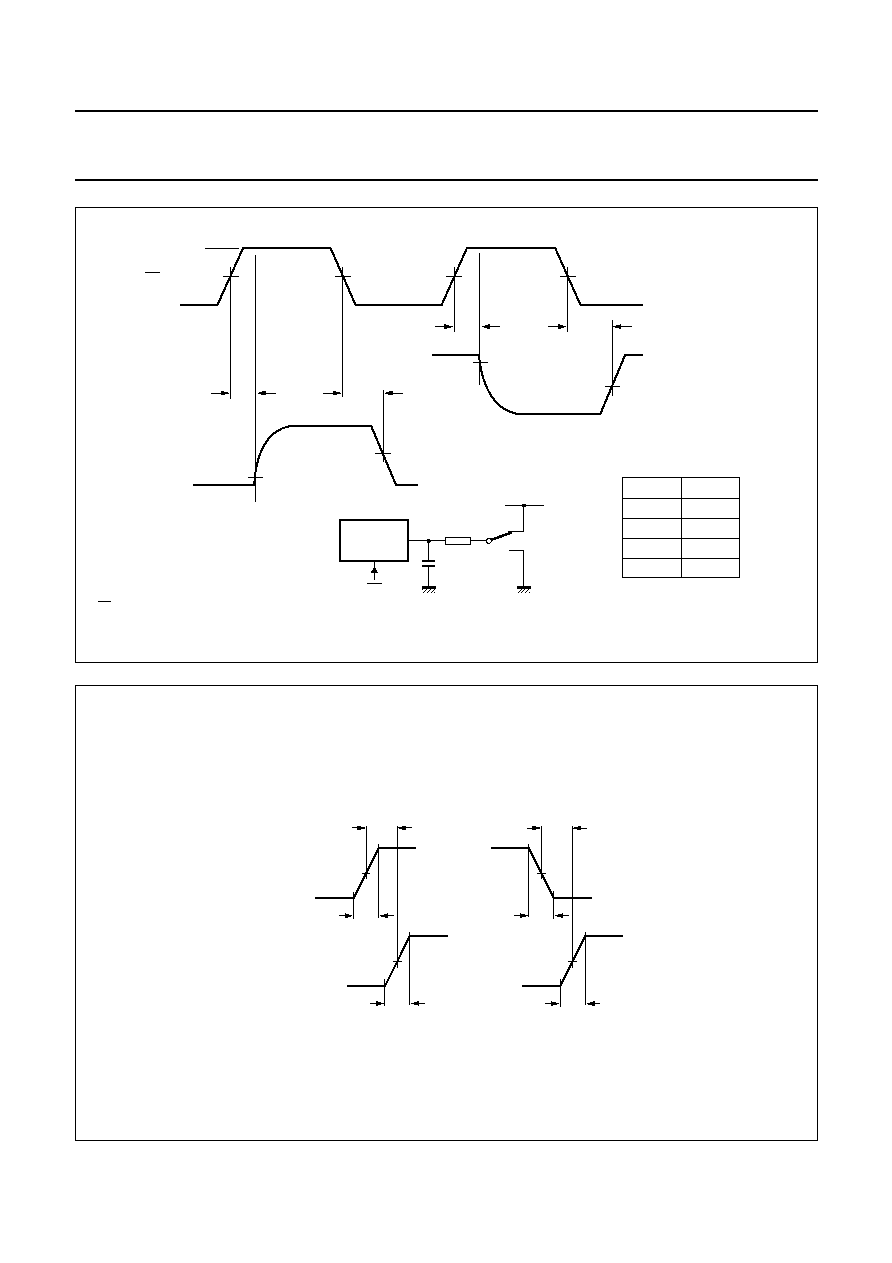
1999 Jan 12
16
Philips Semiconductors
Preliminary specification
10-bit high-speed low-power ADC with
internal reference regulator
TDA8764
handbook, full pagewidth
output
data
output
data
OE
50%
50%
50%
10%
90%
LOW
LOW
HIGH
HIGH
tdZH
tdZL
tdHZ
VCCD
tdLZ
TDA8764
3.3 k
S1
OE
VCCD
15 pF
FCE101
tdLZ
TEST
S1
tdZL
tdHZ
tdZH
VCCD
VCCD
DGND
DGND
Fig.6 Timing diagram and test conditions of 3-state output delay time.
f
OE
= 100 kHz.
Fig.7 Analog input settling time diagram.
MBE566
50%
STLH
t
2 ns
code 0
code 1023
I
50%
0.5 ns
50%
2 ns
STHL
t
50%
0.5 ns
CLK
V

1999 Jan 12
17
Philips Semiconductors
Preliminary specification
10-bit high-speed low-power ADC with
internal reference regulator
TDA8764
INTERNAL PIN CONFIGURATIONS
Fig.8 CMOS data and in range outputs.
handbook, halfpage
MBG915
VCCO
OGND
D9 to D0
IR
Fig.9 Analog inputs.
handbook, halfpage
MGC040 - 1
AGND
V CCA
V I
Fig.10 OE, GRAY and TC inputs.
handbook, halfpage
FCE102
VCCO
OGND
OE
TC
GRAY
Fig.11 V
RB
, V
RM
and V
RT
.
handbook, halfpage
RLAD
MBE558 - 1
VRB
VRM
AGND
VRT
VCCA
REGULATOR
DEC
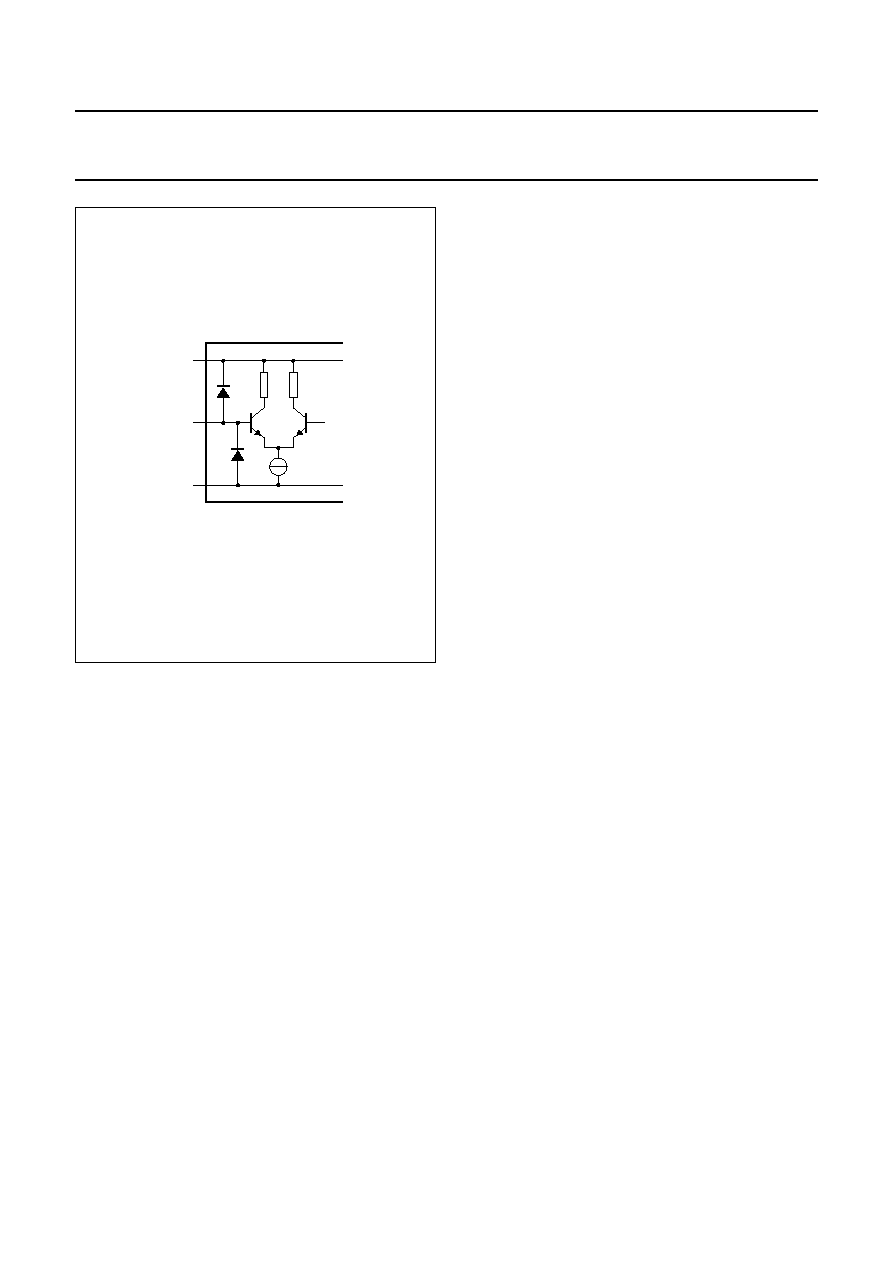
1999 Jan 12
18
Philips Semiconductors
Preliminary specification
10-bit high-speed low-power ADC with
internal reference regulator
TDA8764
Fig.12 CLK input.
handbook, halfpage
FCE103
1.5 V
VCCD
DGND
CLK
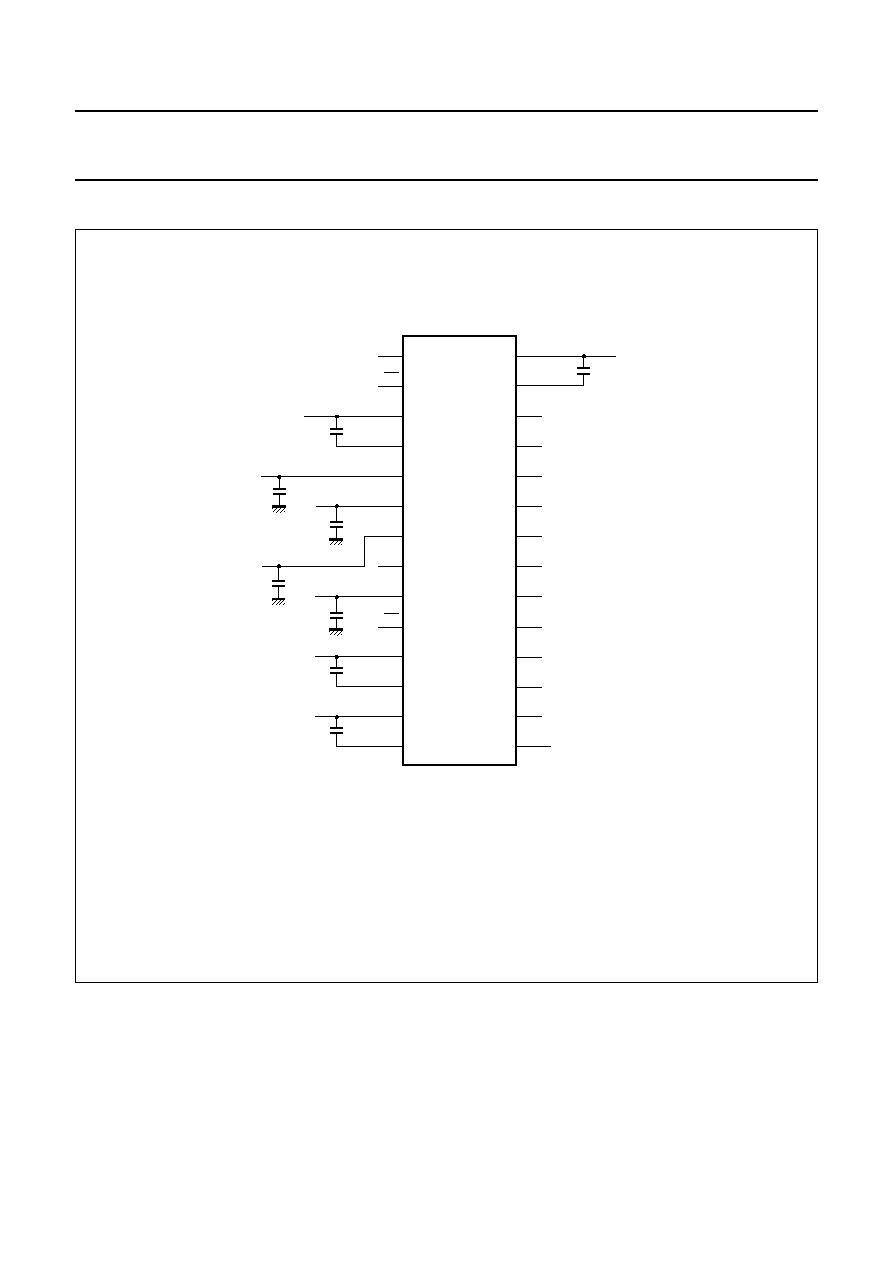
1999 Jan 12
19
Philips Semiconductors
Preliminary specification
10-bit high-speed low-power ADC with
internal reference regulator
TDA8764
APPLICATION INFORMATION
Fig.13 Application diagram (SSOP28).
The analog and digital supplies should be separated and well decoupled.
An application note is available which describes the design and the realization of a demonstration board
that uses TDA8764HL in an application environment.
(1) V
RB
, V
RM
and V
RT
are decoupled to AGND.
(2) Decoupling capacitor for supplies; it must be placed close to the device.
handbook, full pagewidth
28
27
26
25
24
23
22
21
20
19
18
17
TDA8764TS
DGND1
D3
D4
D5
D6
D7
D8
D9
D2
D1
D0
GRAY
1
2
3
4
5
6
7
8
9
10
11
12
CLK
AGND
DEC
VRB
(1)
VCCA
VRT
(1)
VRM
(1)
VCCD2
DGND2
OGND
VCCO
VI
FCE104
16
15
13
14
1 nF
1 nF
1 nF
IR
OE
TC
VCCD1
AGND
4.7 nF
AGND
100 nF
100 nF
AGND
AGND
(2)
100 nF
(2)
(2)
100 nF
(2)
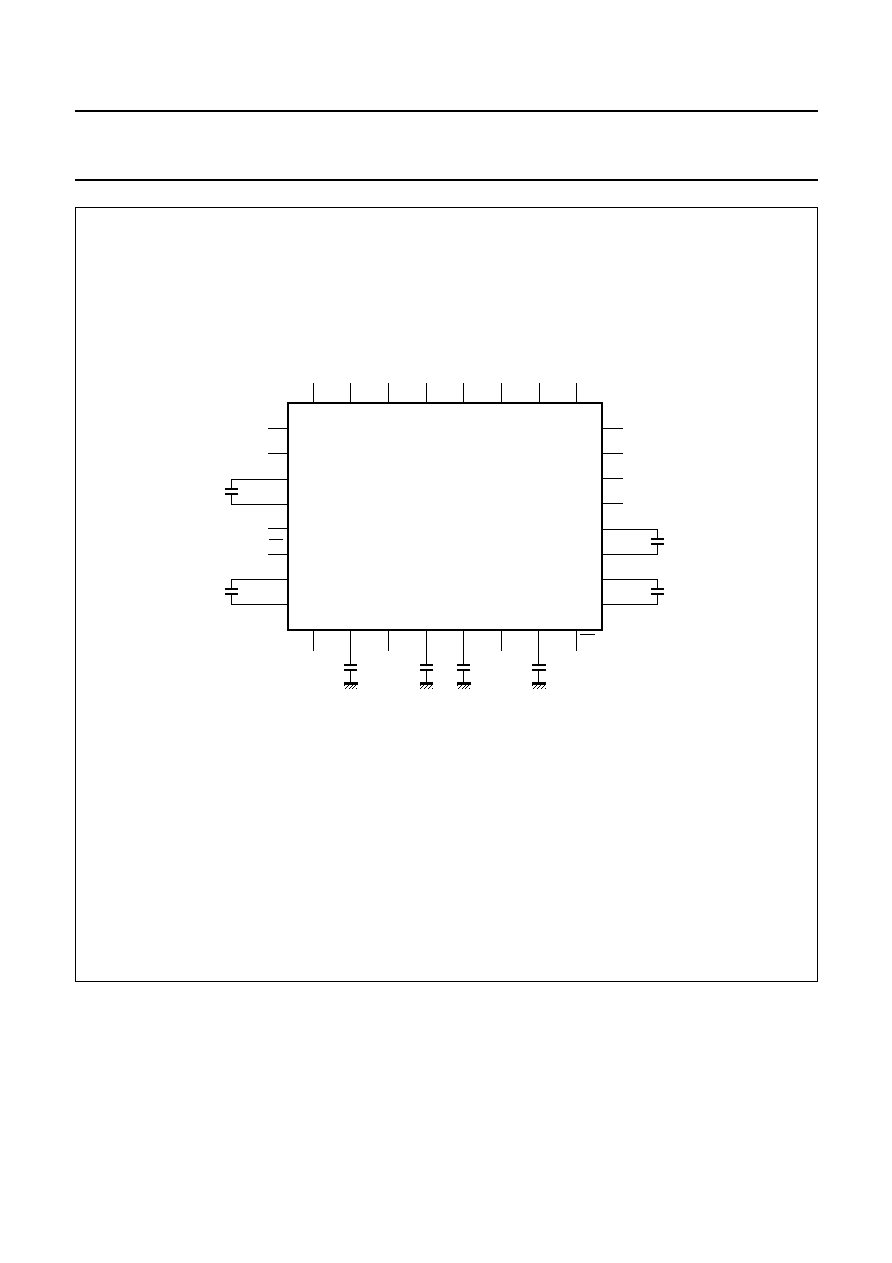
1999 Jan 12
20
Philips Semiconductors
Preliminary specification
10-bit high-speed low-power ADC with
internal reference regulator
TDA8764
Fig.14 Application diagram (LQFP32).
The analog and digital supplies should be separated and well decoupled.
An application note is available which describes the design and the realization of a demonstration board
that uses TDA8764HL in an application environment.
(1) V
RB
, V
RM
and V
RT
are decoupled to AGND.
(2) Decoupling capacitor for supplies; it must be placed close to the device.
handbook, full pagewidth
FCE126
32
1
24
2
23
3
22
4
21
5
20
6
19
7
18
8
17
9
31
10
30
11
29
12
28
13
27
14
26
15
25
16
100 nF
(2)
100 nF
(2)
100 nF
(2)
100 nF
(2)
TDA8764HL
n.c.
IR
DGND1
VCCD1
CLK
VCCA
AGND
1 nF
(1)
AGND
1 nF
(1)
AGND
1 nF
(1)
AGND
4.7 nF
AGND
D3
D4
D5
D6
D7
D8
D9
n.c.
VCCD2
DGND2
OGND
D2
D0
GRAY
D1
VCCO
n.c.
DEC
n.c.
VRB
VI
VRT
VRM
TC
OE

1999 Jan 12
21
Philips Semiconductors
Preliminary specification
10-bit high-speed low-power ADC with
internal reference regulator
TDA8764
PACKAGE OUTLINES
UNIT
A
1
A
2
A
3
b
p
c
D
(1)
E
(1)
(1)
e
H
E
L
L
p
Q
Z
y
w
v
REFERENCES
OUTLINE
VERSION
EUROPEAN
PROJECTION
ISSUE DATE
IEC
JEDEC
EIAJ
mm
0.21
0.05
1.80
1.65
0.38
0.25
0.20
0.09
10.4
10.0
5.4
5.2
0.65
1.25
7.9
7.6
0.9
0.7
1.1
0.7
8
0
o
o
0.13
0.1
0.2
DIMENSIONS (mm are the original dimensions)
Note
1. Plastic or metal protrusions of 0.20 mm maximum per side are not included.
1.03
0.63
SOT341-1
MO-150AH
93-09-08
95-02-04
X
w
M
A
A
1
A
2
b
p
D
H
E
L
p
Q
detail X
E
Z
e
c
L
v
M
A
(A )
3
A
1
14
28
15
0.25
y
pin 1 index
0
2.5
5 mm
scale
SSOP28: plastic shrink small outline package; 28 leads; body width 5.3 mm
SOT341-1
A
max.
2.0

1999 Jan 12
22
Philips Semiconductors
Preliminary specification
10-bit high-speed low-power ADC with
internal reference regulator
TDA8764
0.2
UNIT
A
max.
A
1
A
2
A
3
b
p
c
E
(1)
e
H
E
L
L
p
Z
y
w
v
REFERENCES
OUTLINE
VERSION
EUROPEAN
PROJECTION
ISSUE DATE
IEC
JEDEC
EIAJ
mm
1.60
0.15
0.05
1.5
1.3
0.25
0.27
0.17
0.18
0.12
5.1
4.9
0.5
7.15
6.85
1.0
0.95
0.55
7
0
o
o
0.12
0.1
DIMENSIONS (mm are the original dimensions)
Note
1. Plastic or metal protrusions of 0.25 mm maximum per side are not included.
0.75
0.45
SOT401-1
95-12-19
97-08-04
D
(1)
(1)
(1)
5.1
4.9
H
D
7.15
6.85
E
Z
0.95
0.55
D
b
p
e
E
B
8
D
H
b
p
E
H
v
M
B
D
ZD
A
Z E
e
v
M
A
X
1
32
25
24
17
16
9
A
1
A
L
p
detail X
L
(A )
3
A
2
y
w
M
w
M
0
2.5
5 mm
scale
LQFP32: plastic low profile quad flat package; 32 leads; body 5 x 5 x 1.4 mm
SOT401-1
c
pin 1 index

1999 Jan 12
23
Philips Semiconductors
Preliminary specification
10-bit high-speed low-power ADC with
internal reference regulator
TDA8764
SOLDERING
Introduction to soldering surface mount packages
This text gives a very brief insight to a complex technology.
A more in-depth account of soldering ICs can be found in
our
"Data Handbook IC26; Integrated Circuit Packages"
(document order number 9398 652 90011).
There is no soldering method that is ideal for all surface
mount IC packages. Wave soldering is not always suitable
for surface mount ICs, or for printed-circuit boards with
high population densities. In these situations reflow
soldering is often used.
Reflow soldering
Reflow soldering requires solder paste (a suspension of
fine solder particles, flux and binding agent) to be applied
to the printed-circuit board by screen printing, stencilling or
pressure-syringe dispensing before package placement.
Several methods exist for reflowing; for example,
infrared/convection heating in a conveyor type oven.
Throughput times (preheating, soldering and cooling) vary
between 100 and 200 seconds depending on heating
method.
Typical reflow peak temperatures range from
215 to 250
∞
C. The top-surface temperature of the
packages should preferable be kept below 230
∞
C.
Wave soldering
Conventional single wave soldering is not recommended
for surface mount devices (SMDs) or printed-circuit boards
with a high component density, as solder bridging and
non-wetting can present major problems.
To overcome these problems the double-wave soldering
method was specifically developed.
If wave soldering is used the following conditions must be
observed for optimal results:
∑
Use a double-wave soldering method comprising a
turbulent wave with high upward pressure followed by a
smooth laminar wave.
∑
For packages with leads on two sides and a pitch (e):
≠ larger than or equal to 1.27 mm, the footprint
longitudinal axis is preferred to be parallel to the
transport direction of the printed-circuit board;
≠ smaller than 1.27 mm, the footprint longitudinal axis
must be parallel to the transport direction of the
printed-circuit board.
The footprint must incorporate solder thieves at the
downstream end.
∑
For packages with leads on four sides, the footprint must
be placed at a 45
∞
angle to the transport direction of the
printed-circuit board. The footprint must incorporate
solder thieves downstream and at the side corners.
During placement and before soldering, the package must
be fixed with a droplet of adhesive. The adhesive can be
applied by screen printing, pin transfer or syringe
dispensing. The package can be soldered after the
adhesive is cured.
Typical dwell time is 4 seconds at 250
∞
C.
A mildly-activated flux will eliminate the need for removal
of corrosive residues in most applications.
Manual soldering
Fix the component by first soldering two
diagonally-opposite end leads. Use a low voltage (24 V or
less) soldering iron applied to the flat part of the lead.
Contact time must be limited to 10 seconds at up to
300
∞
C.
When using a dedicated tool, all other leads can be
soldered in one operation within 2 to 5 seconds between
270 and 320
∞
C.

1999 Jan 12
24
Philips Semiconductors
Preliminary specification
10-bit high-speed low-power ADC with
internal reference regulator
TDA8764
Suitability of surface mount IC packages for wave and reflow soldering methods
Notes
1. All surface mount (SMD) packages are moisture sensitive. Depending upon the moisture content, the maximum
temperature (with respect to time) and body size of the package, there is a risk that internal or external package
cracks may occur due to vaporization of the moisture in them (the so called popcorn effect). For details, refer to the
Drypack information in the
"Data Handbook IC26; Integrated Circuit Packages; Section: Packing Methods".
2. These packages are not suitable for wave soldering as a solder joint between the printed-circuit board and heatsink
(at bottom version) can not be achieved, and as solder may stick to the heatsink (on top version).
3. If wave soldering is considered, then the package must be placed at a 45
∞
angle to the solder wave direction.
The package footprint must incorporate solder thieves downstream and at the side corners.
4. Wave soldering is only suitable for LQFP, TQFP and QFP packages with a pitch (e) equal to or larger than 0.8 mm;
it is definitely not suitable for packages with a pitch (e) equal to or smaller than 0.65 mm.
5. Wave soldering is only suitable for SSOP and TSSOP packages with a pitch (e) equal to or larger than 0.65 mm; it is
definitely not suitable for packages with a pitch (e) equal to or smaller than 0.5 mm.
DEFINITIONS
LIFE SUPPORT APPLICATIONS
These products are not designed for use in life support appliances, devices, or systems where malfunction of these
products can reasonably be expected to result in personal injury. Philips customers using or selling these products for
use in such applications do so at their own risk and agree to fully indemnify Philips for any damages resulting from such
improper use or sale.
PACKAGE
SOLDERING METHOD
WAVE
REFLOW
(1)
BGA, SQFP
not suitable
suitable
HLQFP, HSQFP, HSOP, SMS
not suitable
(2)
suitable
PLCC
(3)
, SO, SOJ
suitable
suitable
LQFP, QFP, TQFP
not recommended
(3)(4)
suitable
SSOP, TSSOP, VSO
not recommended
(5)
suitable
Data sheet status
Objective specification
This data sheet contains target or goal specifications for product development.
Preliminary specification
This data sheet contains preliminary data; supplementary data may be published later.
Product specification
This data sheet contains final product specifications.
Limiting values
Limiting values given are in accordance with the Absolute Maximum Rating System (IEC 134). Stress above one or
more of the limiting values may cause permanent damage to the device. These are stress ratings only and operation
of the device at these or at any other conditions above those given in the Characteristics sections of the specification
is not implied. Exposure to limiting values for extended periods may affect device reliability.
Application information
Where application information is given, it is advisory and does not form part of the specification.

1999 Jan 12
25
Philips Semiconductors
Preliminary specification
10-bit high-speed low-power ADC with
internal reference regulator
TDA8764
NOTES

1999 Jan 12
26
Philips Semiconductors
Preliminary specification
10-bit high-speed low-power ADC with
internal reference regulator
TDA8764
NOTES

1999 Jan 12
27
Philips Semiconductors
Preliminary specification
10-bit high-speed low-power ADC with
internal reference regulator
TDA8764
NOTES

Internet: http://www.semiconductors.philips.com
Philips Semiconductors ≠ a worldwide company
© Philips Electronics N.V. 1999
SCA61
All rights are reserved. Reproduction in whole or in part is prohibited without the prior written consent of the copyright owner.
The information presented in this document does not form part of any quotation or contract, is believed to be accurate and reliable and may be changed
without notice. No liability will be accepted by the publisher for any consequence of its use. Publication thereof does not convey nor imply any license
under patent- or other industrial or intellectual property rights.
Middle East: see Italy
Netherlands: Postbus 90050, 5600 PB EINDHOVEN, Bldg. VB,
Tel. +31 40 27 82785, Fax. +31 40 27 88399
New Zealand: 2 Wagener Place, C.P.O. Box 1041, AUCKLAND,
Tel. +64 9 849 4160, Fax. +64 9 849 7811
Norway: Box 1, Manglerud 0612, OSLO,
Tel. +47 22 74 8000, Fax. +47 22 74 8341
Pakistan: see Singapore
Philippines: Philips Semiconductors Philippines Inc.,
106 Valero St. Salcedo Village, P.O. Box 2108 MCC, MAKATI,
Metro MANILA, Tel. +63 2 816 6380, Fax. +63 2 817 3474
Poland: Ul. Lukiska 10, PL 04-123 WARSZAWA,
Tel. +48 22 612 2831, Fax. +48 22 612 2327
Portugal: see Spain
Romania: see Italy
Russia: Philips Russia, Ul. Usatcheva 35A, 119048 MOSCOW,
Tel. +7 095 755 6918, Fax. +7 095 755 6919
Singapore: Lorong 1, Toa Payoh, SINGAPORE 319762,
Tel. +65 350 2538, Fax. +65 251 6500
Slovakia: see Austria
Slovenia: see Italy
South Africa: S.A. PHILIPS Pty Ltd., 195-215 Main Road Martindale,
2092 JOHANNESBURG, P.O. Box 7430 Johannesburg 2000,
Tel. +27 11 470 5911, Fax. +27 11 470 5494
South America: Al. Vicente Pinzon, 173, 6th floor,
04547-130 S√O PAULO, SP, Brazil,
Tel. +55 11 821 2333, Fax. +55 11 821 2382
Spain: Balmes 22, 08007 BARCELONA,
Tel. +34 93 301 6312, Fax. +34 93 301 4107
Sweden: Kottbygatan 7, Akalla, S-16485 STOCKHOLM,
Tel. +46 8 5985 2000, Fax. +46 8 5985 2745
Switzerland: Allmendstrasse 140, CH-8027 ZÐRICH,
Tel. +41 1 488 2741 Fax. +41 1 488 3263
Taiwan: Philips Semiconductors, 6F, No. 96, Chien Kuo N. Rd., Sec. 1,
TAIPEI, Taiwan Tel. +886 2 2134 2865, Fax. +886 2 2134 2874
Thailand: PHILIPS ELECTRONICS (THAILAND) Ltd.,
209/2 Sanpavuth-Bangna Road Prakanong, BANGKOK 10260,
Tel. +66 2 745 4090, Fax. +66 2 398 0793
Turkey: Talatpasa Cad. No. 5, 80640 GÐLTEPE/ISTANBUL,
Tel. +90 212 279 2770, Fax. +90 212 282 6707
Ukraine: PHILIPS UKRAINE, 4 Patrice Lumumba str., Building B, Floor 7,
252042 KIEV, Tel. +380 44 264 2776, Fax. +380 44 268 0461
United Kingdom: Philips Semiconductors Ltd., 276 Bath Road, Hayes,
MIDDLESEX UB3 5BX, Tel. +44 181 730 5000, Fax. +44 181 754 8421
United States: 811 East Arques Avenue, SUNNYVALE, CA 94088-3409,
Tel. +1 800 234 7381, Fax. +1 800 943 0087
Uruguay: see South America
Vietnam: see Singapore
Yugoslavia: PHILIPS, Trg N. Pasica 5/v, 11000 BEOGRAD,
Tel. +381 11 62 5344, Fax.+381 11 63 5777
For all other countries apply to: Philips Semiconductors,
International Marketing & Sales Communications, Building BE-p, P.O. Box 218,
5600 MD EINDHOVEN, The Netherlands, Fax. +31 40 27 24825
Argentina: see South America
Australia: 34 Waterloo Road, NORTH RYDE, NSW 2113,
Tel. +61 2 9805 4455, Fax. +61 2 9805 4466
Austria: Computerstr. 6, A-1101 WIEN, P.O. Box 213,
Tel. +43 1 60 101 1248, Fax. +43 1 60 101 1210
Belarus: Hotel Minsk Business Center, Bld. 3, r. 1211, Volodarski Str. 6,
220050 MINSK, Tel. +375 172 20 0733, Fax. +375 172 20 0773
Belgium: see The Netherlands
Brazil: see South America
Bulgaria: Philips Bulgaria Ltd., Energoproject, 15th floor,
51 James Bourchier Blvd., 1407 SOFIA,
Tel. +359 2 68 9211, Fax. +359 2 68 9102
Canada: PHILIPS SEMICONDUCTORS/COMPONENTS,
Tel. +1 800 234 7381, Fax. +1 800 943 0087
China/Hong Kong: 501 Hong Kong Industrial Technology Centre,
72 Tat Chee Avenue, Kowloon Tong, HONG KONG,
Tel. +852 2319 7888, Fax. +852 2319 7700
Colombia: see South America
Czech Republic: see Austria
Denmark: Sydhavnsgade 23, 1780 COPENHAGEN V,
Tel. +45 33 29 3333, Fax. +45 33 29 3905
Finland: Sinikalliontie 3, FIN-02630 ESPOO,
Tel. +358 9 615 800, Fax. +358 9 6158 0920
France: 51 Rue Carnot, BP317, 92156 SURESNES Cedex,
Tel. +33 1 4099 6161, Fax. +33 1 4099 6427
Germany: Hammerbrookstraþe 69, D-20097 HAMBURG,
Tel. +49 40 2353 60, Fax. +49 40 2353 6300
Greece: No. 15, 25th March Street, GR 17778 TAVROS/ATHENS,
Tel. +30 1 489 4339/4239, Fax. +30 1 481 4240
Hungary: see Austria
India: Philips INDIA Ltd, Band Box Building, 2nd floor,
254-D, Dr. Annie Besant Road, Worli, MUMBAI 400 025,
Tel. +91 22 493 8541, Fax. +91 22 493 0966
Indonesia: PT Philips Development Corporation, Semiconductors Division,
Gedung Philips, Jl. Buncit Raya Kav.99-100, JAKARTA 12510,
Tel. +62 21 794 0040 ext. 2501, Fax. +62 21 794 0080
Ireland: Newstead, Clonskeagh, DUBLIN 14,
Tel. +353 1 7640 000, Fax. +353 1 7640 200
Israel: RAPAC Electronics, 7 Kehilat Saloniki St, PO Box 18053,
TEL AVIV 61180, Tel. +972 3 645 0444, Fax. +972 3 649 1007
Italy: PHILIPS SEMICONDUCTORS, Piazza IV Novembre 3,
20124 MILANO, Tel. +39 2 6752 2531, Fax. +39 2 6752 2557
Japan: Philips Bldg 13-37, Kohnan 2-chome, Minato-ku,
TOKYO 108-8507, Tel. +81 3 3740 5130, Fax. +81 3 3740 5077
Korea: Philips House, 260-199 Itaewon-dong, Yongsan-ku, SEOUL,
Tel. +82 2 709 1412, Fax. +82 2 709 1415
Malaysia: No. 76 Jalan Universiti, 46200 PETALING JAYA, SELANGOR,
Tel. +60 3 750 5214, Fax. +60 3 757 4880
Mexico: 5900 Gateway East, Suite 200, EL PASO, TEXAS 79905,
Tel. +9-5 800 234 7381, Fax +9-5 800 943 0087
Printed in The Netherlands
295002/750/01/pp28
Date of release: 1999 Jan 12
Document order number:
9397 750 04632



























